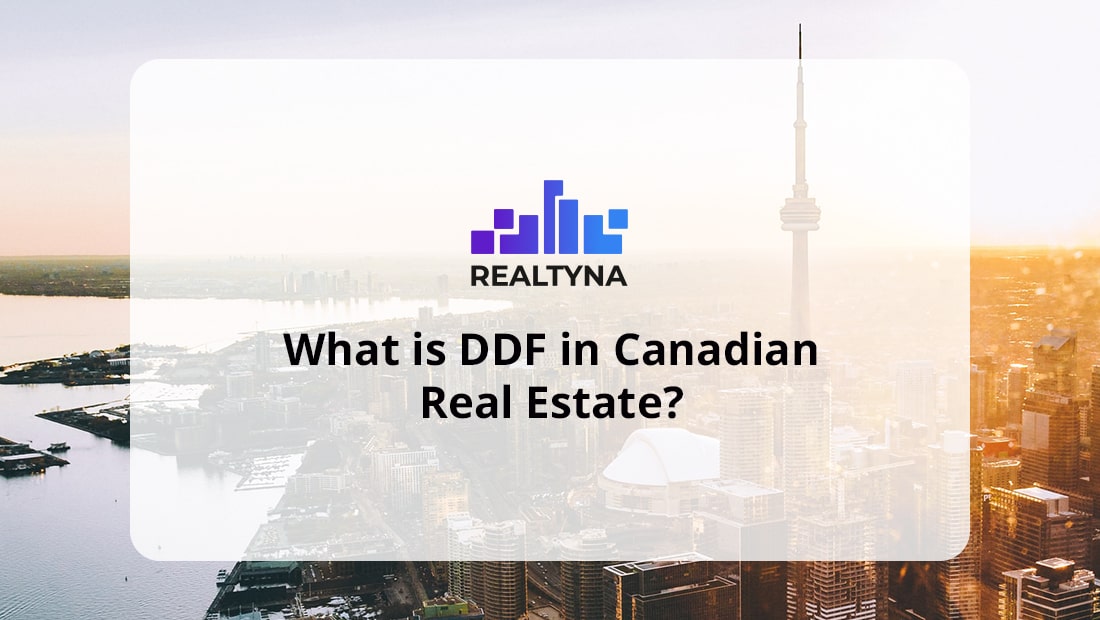
What Is DDF In Canadian Real Estate?
It’s already well known. Technology can help you succeed in your real estate business. The main issue facing realtors is what technologies to implement and services to provide with them. One of the most important technologies in Canada these days is DDF. No matter the listing type—sale, rent, mortgages, etc—DDF can streamline an agent’s work.
Data Distribution Facility, known commonly as DDF, is a nationwide property search solution in Canada. It was created by the Canadian Real Estate Association (CREA) in 2012. The DDF works a lot like the MLS in the USA.
It is an online service that provides access to a national pool of listings and helps to measure the traffic of these listings.
DDF is available only for the Canadian Real Estate Association. It allows members to choose where their listings are displayed. It also allows homebuyers to search available listings across Canada.
NOTE: DDF and IDX provide similar services. But while IDX can provide agents and brokers with all active listings in a certain region, DDF provides listings across all of Canada. If you want to know more about IDX tech, check out What Does IDX Do
Benefits of using the DDF in real estate
CREA DDF offers a number of advantages to participants including improved listing promotion and marketing analysis services, as well as access to one of the largest databases of homes in North America. We go into more detail below.
1. Better Exposure
By participating in DDF, agents and brokers are able to attract a national audience to their listings. This can increase competition for the home, resulting in more offers, higher prices, and fewer days on market.
This exposure is especially important for agents in rural areas who may not have access to IDX services in their region.
2. Easy Syndication
Agents and brokers are able to exert more control over their listings through the syndication options. With a few clicks they are able to decide where they want their listings to appear.
This can save agents time by avoiding the paperwork and development necessary to work with syndication sites one by one.
3. Listings Data
CREA DDF automatically generates statistics on the performance of participant listings. This can help agents and brokers evaluate marketing techniques and understand better the market trends in their communities.
4. Fast Updates
Any listing updates are automatically made in the DDF and pushed to syndication sites, so clients are always seeing the most up-to-date information.
How the DDF works
Now that we understand the importance of data in real estate and the benefits of using the DDF, let’s take a closer look at how the DDF works.
The DDF operates on a simple yet powerful concept – data syndication. Real estate boards and associations across the country contribute property data to the DDF, making it a comprehensive and reliable source of information. This data is then standardized and made available to real estate professionals through a variety of channels.
One of the key components of the DDF is the data feed. Real estate boards provide their data to the DDF through a secure feed, ensuring that the information is accurate and up-to-date. The DDF then processes this data and makes it available to its users.
Key features and functionalities of the DDF
The DDF offers a range of features and functionalities that make it an indispensable tool for real estate professionals. Let’s explore some of the key features of the DDF.
Firstly, the DDF provides a search functionality that allows you to easily find properties based on your specific criteria. Whether you are looking for a residential property in a particular neighborhood or a commercial property with specific amenities, the DDF’s search functionality makes it quick and easy to find what you’re looking for.
In addition to property search, the DDF also offers advanced filtering options. You can refine your search results by factors such as price range, property type, and more. This allows you to narrow down your options and find properties that meet your exact requirements.
Another powerful feature of the DDF is the ability to save and track properties. With the DDF, you can create personalized lists of properties that you are interested in. This makes it easy to keep track of potential leads and follow up on them when the time is right.
Integrating the DDF into your real estate business
Now that you have a good understanding of how the DDF works and its key features, let’s explore how you can integrate the DDF into your real estate business.
Firstly, it’s important to ensure that you have access to the DDF. This typically involves becoming a member of the real estate board or association that provides data to the DDF. Once you have access, you can start leveraging the power of the DDF in your day-to-day operations.
One way to integrate the DDF into your business is by using it as a research tool. Whether you are a real estate agent, a homebuyer, or an investor, the DDF can provide valuable insights into the market. By analyzing trends and market data available through the DDF, you can identify opportunities and make informed decisions.
Additionally, the DDF can be used as a marketing tool. As a real estate professional, you can use the data available through the DDF to create compelling property listings and marketing materials. By showcasing accurate and up-to-date information, you can attract more potential buyers and increase your chances of closing deals.
Common misconceptions about the DDF
Despite its many advantages, there are some common misconceptions about the DDF that need to be addressed.
One misconception is that the DDF is only available to large real estate firms. In reality, the DDF is accessible to real estate professionals of all sizes. Whether you are an independent agent or part of a small brokerage, you can benefit from the DDF’s features and functionalities.
Another misconception is that the DDF is limited to certain geographic areas. While it’s true that the DDF’s coverage may vary depending on the real estate boards that contribute data, it is a nationwide platform. This means that you can access property data from across the country, allowing you to expand your reach and explore new opportunities.
Best practices for using the DDF effectively
To make the most of the DDF, it’s important to follow some best practices. Here are a few tips to help you use the DDF effectively:
1. Familiarize yourself with the search and filtering options available through the DDF. This will help you quickly find properties that meet your criteria.
2. Regularly update your saved lists of properties. The real estate market is dynamic, and properties may come on and off the market. By keeping your lists up to date, you can ensure that you are always working with accurate information.
3. Use the DDF as a research tool. Take advantage of the market data and trends available through the DDF to gain insights and identify opportunities.
4. Leverage the DDF’s marketing capabilities. Use the data available through the DDF to create compelling property listings and marketing materials that attract potential buyers.
DDF vs. other data distribution platforms in real estate
It’s important to note that the DDF is not the only data distribution platform in the real estate industry. There are other platforms available that offer similar services. So, how does the DDF compare to these other platforms?
One of the key advantages of the DDF is its comprehensive coverage. As mentioned earlier, the DDF sources data from various real estate boards, making it a reliable and comprehensive source of information. This sets it apart from other platforms that may have limited coverage.
Another advantage of the DDF is its user-friendly interface. The DDF is designed to be intuitive and easy to use, making it accessible to real estate professionals of all skill levels. This is an important consideration, especially for those who may not be tech-savvy.
Conclusion: Harnessing the power of the DDF in your real estate endeavors
In conclusion, the Data Distribution Facility (DDF) is a powerful tool that can revolutionize the way you access and distribute property data in the real estate industry. By harnessing the power of the DDF, you can make informed decisions, save valuable time, and gain a competitive edge.
Whether you are a real estate agent, a homebuyer, or an investor, understanding how the DDF works and integrating it into your business can open up new opportunities and help you achieve success in the fast-paced world of real estate.
If you need any help about the DDF integration on your website, feel free to contact us in any moment.



Sorry, the comment form is closed at this time.